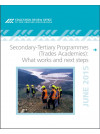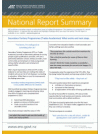In this evaluation the Education Review Office (ERO) explored how well 15 of the 24 Secondary-Tertiary Programmes (STPs, also known as ‘Trades Academies’) in New Zealand were meeting the needs of students at risk of not staying or succeeding in education.
An STP is a partnership between tertiary education organisations (TEOs) and schools. STPs aim to meet the needs of students at risk of disengaging from education by raising their achievement levels and promoting positive transitions to further education, training or work. Students attend courses provided by the TEO. Most commonly these operate for one day each week and are trades-based, practical programmes that have relevance to the students’ learning pathways.1 For the other four days a week, students attend their school and participate in the curriculum available there. Broadly speaking, the partners are funded for the students according to the time spent in each organisation.
Since the first STPs were established in 2011,2 they have experienced considerable growth in student numbers and are achieving very positive results. Most students gain qualifications including National Certificate of Educational Achievement (NCEA) Level 2, National Certification in trade-related skills or NCEA Level 3 industry standards.
ERO found that the curriculum of the STPs was relevant to most students and its delivery engaged and motivated them. This was instrumental in changing their attitudes to learning and enabled them to see themselves as capable learners. Students developed key skills and competencies in the programmes offered by the STPs and gained an appreciation of the expectations relating to tertiary study and the requirements of a workplace. They understood the value of the theory behind their practical work and that qualifications provided them with opportunities for the future. Students were well supported by teachers at school and the tutors at the tertiary organisations. They generally developed a clear learning pathway which gave them a sense of purpose. Most students experienced positive transitions to further education, training or work.
A student summarises the outcomes well:
I finally have a true vision of what I want to do, by what I know I can do since being on this course, and I am grateful to have had this opportunity to do so.
The STP partnerships between the leaders in schools and TEOs were strengthening, although there were still areas for improvement. Notably, these areas included establishing clear guidelines for STP’s practices, roles and responsibilities, and the development of a curriculum where the tertiary and secondary components informed and complemented each other. Effective STP partnerships depended on strong leadership of the director working with leaders in the TEOs and schools. Where strong collaboration was evident, the STP partners had a shared vision and made sound decisions, reliant on strong self-review practices. They recognised the value of an integrated curriculum, informed by the carefully identified needs and learning pathways of their shared students. These STPs were also establishing documentation to promote sustainability and consistency of practice.
STP partners worked together well to understand each other’s organisational needs, clarify the impact of the funding models, and to overcome difficulties experienced as a result of different student management systems, structures and reporting requirements. The Ministry of Education continues to support STPs and is focused on enabling what is best for students.
ERO is confident that STPs will continue to meet the educational needs of a significant number of young people who are at risk of disengaging from education or not achieving NCEA Level 2.


